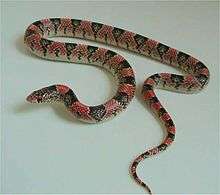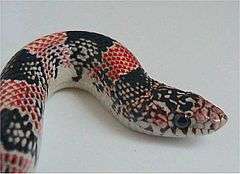Long-nosed snake
| Long-nosed snake | |
|---|---|
 | |
| Texas long-nosed snake Rhinocheilus lecontei tessellatus | |
| Scientific classification | |
| Kingdom: | Animalia |
| Phylum: | Chordata |
| Subphylum: | Vertebrata |
| Class: | Reptilia |
| Order: | Squamata |
| Suborder: | Serpentes |
| Family: | Colubridae |
| Subfamily: | Colubrinae |
| Genus: | Rhinocheilus Baird & Girard, 1853 |
| Species: | R. lecontei |
| Binomial name | |
| Rhinocheilus lecontei Baird & Girard, 1853 | |
| Synonyms | |
The long-nosed snake, Rhinocheilus lecontei, is a species of nonvenomous colubrid snake, which is endemic to North America. It is the only species in the genus Rhinocheilus, but has four recognized subspecies, though more modern research has cast some doubt on that classification.
Etymology
The specific name, lecontei, commemorates American entomologist John Lawrence Le Conte (1825-1883).[4]
Description
Long-nosed snakes are distinguished by a long, slightly upturned snout, which is the origin of their common name. They are tricolor, vaguely resembling a coral snake with black and red saddling that almost looks like banding, on a yellow or cream-colored background, which can look somewhat like yellow banding. Cream-colored spots within the black saddles are a distinct characteristic of the long-nosed snake. They differ from all other harmless snakes in the United States by having undivided subcaudal scales.[5] They average around 30 inches (76 cm) in total length.
Behavior
Long-nosed snakes are shy, nocturnal burrowing snakes. They spend most of their time buried underground.
Diet
Long-nosed snakes feed on lizards, amphibians, and sometimes smaller snakes and infrequently rodents.
Reproduction
Long-nosed snakes are oviparous, laying clutches of 4-9 eggs in the early summer, which hatch out in the late summer or early fall.
Defense
Long-nosed snakes are not apt to bite, but will release a foul smelling musk and blood[6] from their cloaca as a defense mechanism if harassed.
Habitat
Long-nosed Snakes inhabit dry, often rocky, grassland areas.
Geographic range
They are found in northern Mexico from San Luis Potosí to Chihuahua, and into the southwestern United States, in California, Nevada, Utah, Idaho, Arizona, New Mexico, southeastern Colorado, southwestern Kansas,[7] Oklahoma,[8] and Texas.[7]
Subspecies
- Mexican long-nosed snake, Rhinocheilus lecontei antonii Dugès, 1886
- Isla Cerralvo long-nosed snake, Rhinocheilus lecontei etheridgei Grismer, 1990
- Western long-nosed snake, Rhinocheilus lecontei lecontei Baird & Girard, 1853
- Texas long-nosed snake, Rhinocheilus lecontei tessellatus Garman, 1883

In captivity
Long-nosed snakes are not often found in the exotic pet trade as they frequently reject rodent-based diets that are most readily available for captive snakes.
References
- ↑ Cope, E.D. 1866. On the REPTILIA and BATRACHIA of the Sonoran Province of the Nearctic Region. Proc. Acad. Nat. Sci. Philadelphia. "1866" [18]: 300-314. ("Rhinochilus lecontei ", p. 304.)
- ↑ Boulenger, G.A. 1894. Catalogue of the Snakes in the British Museum (Natural History). Volume II., Containing the Conclusion of the Colubridæ Aglyphæ. Trustees of the British Museum (Natural History). (Taylor and Francis, Printers.) London. xi + 382 pp. + Plates I.- XX. ("Rhinochilus lecontii ", pp. 212-213.)
- ↑ Stejneger, L., & T. Barbour. 1917. A Check List of North American Amphibians and Reptiles. Harvard University Press. Cambridge, Massachusetts. 125 pp. (Rhinocheilus lecontei, p. 91.)
- ↑ Beolens, B.; M. Watkins; M. Grayson. 2011. The Eponym Dictionary of Reptiles. Johns Hopkins University Press. Baltimore. xiii + 296 pp. ISBN 978-1-4214-0135-5. (Rhinocheilus lecontei, p. 154.)
- ↑ Schmidt, K.P., and D.D. Davis. 1941. Field Book of Snakes of the United States and Canada. G.P. Putnam's Sons. New York. 365 pp. (Rhinocheilus lecontei, pp. 194-196, Figure 61. + Plate 21.)
- ↑ McCoy, C.J., Jr., and A.V. Bianculli. 1966. Defensive behavior of Rhinocheilus lecontei. Journal of the Ohio Herpetological Society 5 (4): 166.
- 1 2 The Reptile Database. www.reptile-database.org.
- ↑ T. Robyn captured, identified, and released one near Lawton, Oklahoma, 2010.
External links
- Species Rhinocheilus lecontei at The Reptile Database
- USGS: Rhinocheilus lecontei
- "IUCN Red List of Threatened Species". Retrieved 2008-09-06.
| Wikimedia Commons has media related to Rhinocheilus lecontei. |
- WhoZoo: Long-nosed Snake
- NatureServe Explorer: w/ 2 RangeMaps: Rhinocheilus lecontei. Click "DISTRIBUTION" for maps.
Further reading
- Baird, S.F., and C. Girard. 1853. Catalogue of North American Reptiles in the Museum of the Smithsonian Institution. Part I.—Serpents. Smithsonian Institution. Washington, District of Columbia. xvi + 172 pp. (Genus Rhinocheilus, p. 120; and species Rhinocheilus lecontei, pp. 120–121.)
- Conant, R., and W. Bridges. 1939. What Snake Is That? A Field Guide to the Snakes of the United States East of the Rocky Mountains. (With 108 drawings by E. Malnate.) D. Appleton-Century. New York and London. Frontispiece map + viii + 163 pp. + Plates A-C, 1-32. (Rhinocheilus lecontei, p. 86 + Plate 14, Figure 41.)
- Smith, H.M., and E.D. Brodie, Jr. 1982. Reptiles of North America: A Guide to Field Identification. Golden Press. New York. 240 pp. ISBN 0-307-13666-3 (paperback). (Rhinocheilus lecontei, pp. 164–165.)
- Stebbins, R.C. 2003. A Field Guide to Western Reptiles and Amphibians, Third Edition. The Peterson Field Guide Series ®. Houghton Mifflin. Boston and New York. xiii + 533 pp. ISBN 0-395-98272-3 (paperback). (Rhinocheilus lecontei, pp. 370–371 + Plate 44 + Map 155.)
- Wright, A.H., and A.A. Wright. 1957. Handbook of Snakes of the United States and Canada. Comstock. Ithaca and London. 1,105 pp. (in 2 volumes) (Genus Rhinocheilus, p. 630-633 + Figure 19 on p. 69.) (species Rhinocheilus lecontei, pp. 633–644, Figures 183-187, Map 48.)
- Zim, H.S., and H.M. Smith. 1956. Reptiles and Amphibians: A Guide to Familiar American Species. A Golden Nature Guide. Simon and Schuster. New York. 160 pp. ("LONG-NOSED SNAKE", Rhinocheilus lecontei, pp. 101, 156.)
